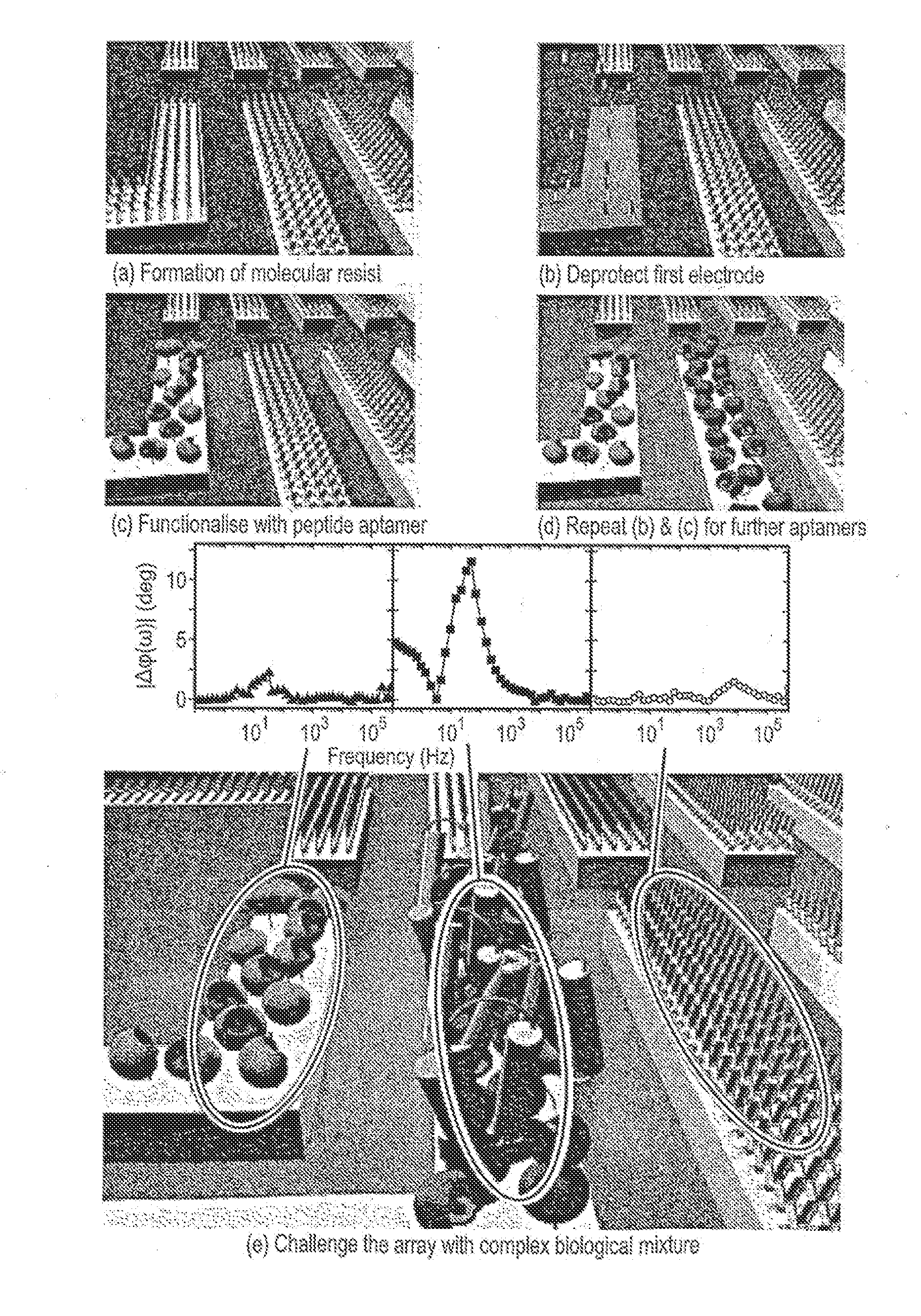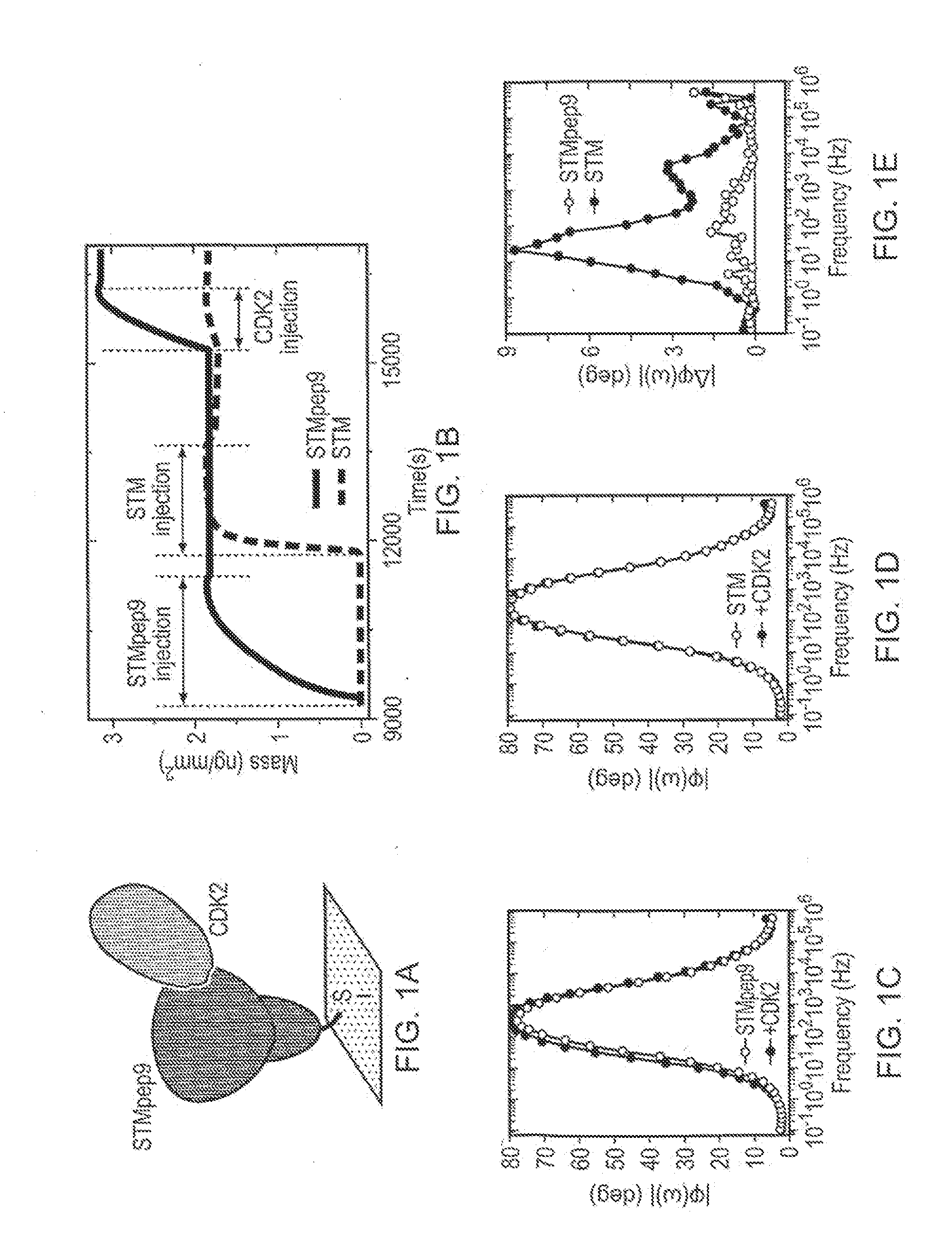Methods and Devices for Detecting Structural Changes in a Molecule Measuring Electrochemical Impedance
a technology of electrochemical impedance and structural change, applied in the field of biological molecules, can solve the problems of preventing dots from being formed below certain threshold sizes, problems arise, etc., and achieve the effects of reducing noise or spurious signals, reducing electrode diameter, and reducing the size of electrodes
- Summary
- Abstract
- Description
- Claims
- Application Information
AI Technical Summary
Benefits of technology
Problems solved by technology
Method used
Image
Examples
example 1
[0166]Two different peptide aptamers were employed displayed by cysteine-modified STM with affinities for cyclin-dependent kinase 2 (CDK2) and CDK4. Both CDK2 and CDK4 belong to a group of proteins involved in the regulation of the cell cycle; they are functionally related, yet share less than 50% sequence identity. The two CDK-interacting peptide aptamers (named STMpep2 and STMpep9, where the subscripts pep2 and pep9 refer to two different peptide sequences) were generated by insertion of oligonucleotides encoding the CDK-interacting peptide sequence derived from the thioredoxin-based peptide aptamers of Colas et al. into restriction sites in the open reading frame encoding the STM protein scaffold. The binding of CDK to the peptide aptamers was confirmed, in vivo and in vitro, using yeast-2-hybrid screening and fluorescence resonant energy transfer spectroscopy (FRET), respectively.
[0167]Although the peptide-insert region is predicted to be far from the surface when the STM-scaffo...
example 2
[0174]In order to assess the suitability of our sensing strategy for the detection of proteins in biologically relevant specimens, in which the proteins of interest are only present at very low abundance and in complex mixtures, we prepared Au electrodes functionalised with STMpep9 and STM. These were then exposed to 35 μl of a solution containing a mixture of cell products, including CDK2, generated by lysis (dissolution) of CDK2-expressing yeast cells. The use of a lysate not only allows us to confirm the specificity of the STMpep9 aptamer for binding of CDK2, but also allows us to assess our sensing device using a complex biological sample which closely resembles those used in typical medical diagnostics. Following exposure to yeast lysate, the devices were thoroughly washed in order to remove any non-specifically bound material.
[0175]The phases φ of the complex impedances measured for the different devices are shown in FIG. 2. While a distinct shift in φ(ω) is observed between 1...
example 3
[0176]Electrode array devices consisting of ten individually addressable Au micro-electrodes separated by 15 μm, were fabricated on n-doped silicon substrates capped with a 500 nm thermal oxide using a bi-layer resist process. The electrodes were of 20 μm width. Following fabrication, each device was mounted in a header package and wire bonded to provide electrical connection to each micro-electrode. To demonstrate the suitability of our technique for array format sensing, we functionalised different closely-spaced electrodes of the array with two different peptide aptamers, STMpep9 and STMpep2.
[0177]Selective functionalisation of the micro-electrodes was achieved through a molecular masking process illustrated in FIG. 3. Following the fabrication of the electrode arrays, the devices were immersed in a 10 mM methyl-terminated poly(ethlyene-glycol)6-thiol (mPEG, Polypure, Norway) ethanolic solution for 96 hours (FIG. 3(a)). This mPEG layer prevents non-specific binding of proteins d...
PUM
| Property | Measurement | Unit |
|---|---|---|
| diameter | aaaaa | aaaaa |
| diameter | aaaaa | aaaaa |
| diameter | aaaaa | aaaaa |
Abstract
Description
Claims
Application Information
 Login to View More
Login to View More - R&D
- Intellectual Property
- Life Sciences
- Materials
- Tech Scout
- Unparalleled Data Quality
- Higher Quality Content
- 60% Fewer Hallucinations
Browse by: Latest US Patents, China's latest patents, Technical Efficacy Thesaurus, Application Domain, Technology Topic, Popular Technical Reports.
© 2025 PatSnap. All rights reserved.Legal|Privacy policy|Modern Slavery Act Transparency Statement|Sitemap|About US| Contact US: help@patsnap.com



